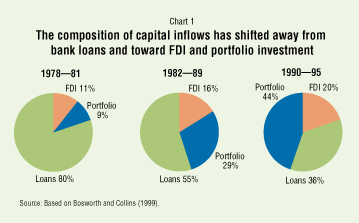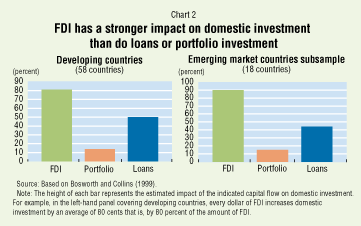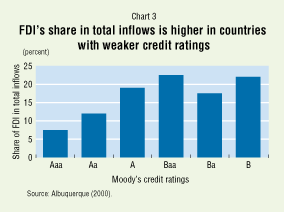 About F&D Subscribe Back Issues Write Us Copyright Information |
How Beneficial Is Foreign Direct Investment for Developing Countries? Prakash Loungani and Assaf Razin The resilience of foreign direct investment during financial crises may lead many developing countries to regard it as the private capital inflow of choice. Although there is substantial evidence that such investment benefits host countries, they should assess its potential impact carefully and realistically. Foreign direct investment (FDI) has proved to be resilient during financial crises. For instance, in East Asian countries, such investment was remarkably stable during the global financial crises of 1997-98. In sharp contrast, other forms of private capital flows—portfolio equity and debt flows, and particularly short-term flows—were subject to large reversals during the same period (see Dadush, Dasgupta, and Ratha, 2000; and Lipsey, 2001). The resilience of FDI during financial crises was also evident during the Mexican crisis of 1994-95 and the Latin American debt crisis of the 1980s. This resilience could lead many developing countries to favor FDI over other forms of capital flows, furthering a trend that has been in evidence for many years (see Chart 1). Is the preference for FDI over other forms of private capital inflows justified? This article sheds some light on this issue by reviewing recent theoretical and empirical work on its impact on developing countries' investment and growth.

The case for free capital flows Economists tend to favor the free flow of capital across national borders because it allows capital to seek out the highest rate of return. Unrestricted capital flows may also offer several other advantages, as noted by Feldstein (2000). First, international flows of capital reduce the risk faced by owners of capital by allowing them to diversify their lending and investment. Second, the global integration of capital markets can contribute to the spread of best practices in corporate governance, accounting rules, and legal traditions. Third, the global mobility of capital limits the ability of governments to pursue bad policies. In addition to these advantages, which in principle apply to all kinds of private capital inflows, Feldstein (2000) and Razin and Sadka (forthcoming) note that the gains to host countries from FDI can take several other forms:
Of course, countries often choose to forgo some of this revenue when they cut corporate tax rates in an attempt to attract FDI from other locations. For instance, the sharp decline in corporate tax revenues in some of the member countries of the Organization for Economic Cooperation and Development (OECD) may be the result of such competition. (For a discussion, see the article by Reint Gropp and Kristina Kostial in this issue.) In principle, therefore, FDI should contribute to investment and growth in host countries through these various channels. FDI versus other flows Despite the strong theoretical case for the advantages of free capital flows, the conventional wisdom now seems to be that many private capital flows pose countervailing risks. Hausmann and Fernández-Arias (2000) suggest why many host countries, even when they are in favor of capital inflows, view international debt flows, especially of the short-term variety, as "bad cholesterol": It [short-term lending from abroad] is driven by speculative considerations based on interest rate differentials and exchange rate expectations, not on long-term considerations. Its movement is often the result of moral hazard distortions such as implicit exchange rate guarantees or the willingness of governments to bailout the banking system. It is the first to run for the exits in times of trouble and is responsible for the boom-bust cycles of the 1990s. In contrast, FDI is viewed as "good cholesterol" because it can confer the benefits enumerated earlier. An additional benefit is that FDI is thought to be "bolted down and cannot leave so easily at the first sign of trouble." Unlike short-term debt, direct investments in a country are immediately repriced in the event of a crisis. Recent evidence To what extent is there empirical support for such claims of the beneficial impact of FDI? A comprehensive study by Bosworth and Collins (1999) provides evidence on the effect of capital inflows on domestic investment for 58 developing countries during 1978-95. The sample covers nearly all of Latin America and Asia, as well as many countries in Africa. The authors distinguish among three types of inflows: FDI, portfolio investment, and other financial flows (primarily bank loans). Bosworth and Collins find that an increase of a dollar in capital inflows is associated with an increase in domestic investment of about 50 cents. (Both capital inflows and domestic investment are expressed as percentages of GDP.) This result, however, masks significant differences among types of inflow. FDI appears to bring about a one-for-one increase in domestic investment; there is virtually no discernible relationship between portfolio inflows and investment (little or no impact); and the impact of loans falls between those of the other two. These results hold both for the 58-country sample and for a subset of 18 emerging markets. (See Chart 2.) Bosworth and Collins conclude: "Are these benefits of financial inflows sufficient to offset the evident risks of allowing markets to freely allocate capital across the borders of developing countries? The answer would appear to be a strong yes for FDI."

Borensztein, De Gregorio, and Lee (1998) find that FDI increases economic growth when the level of education in the host country—a measure of its absorptive capacity—is high. The World Bank's latest Global Development Finance (2001) report summarizes the findings of several other studies on the relationships between private capital flows and growth, and also provides new evidence on these relationships. (For a summary, see the article by Deepak Mishra, Ashoka Mody, and Antu Panini Murshid in this issue.) Reasons for caution? Despite the evidence presented in recent studies, other work indicates that developing countries should be cautious about taking too uncritical an attitude toward the benefits of FDI. Is a high FDI share a sign of weakness? Hausmann and Fernández-Arias (2000) point to reasons why a high share of FDI in total capital inflows may be a sign of a host country's weakness rather than its strength. One striking feature of FDI flows is that their share in total inflows is higher in riskier countries, with risk measured either by countries' credit ratings for sovereign (government) debt or by other indicators of country risk (see Chart 3). There is also some evidence that its share is higher in countries where the quality of institutions is lower. What can explain these seemingly paradoxical findings? One explanation is that FDI is more likely than other forms of capital flows to take place in countries with missing or inefficient markets. In such settings, foreign investors will prefer to operate directly instead of relying on local financial markets, suppliers, or legal arrangements. The policy implications of this view, according to Albuquerque (2000), are "that countries trying to expand their access to international capital markets should concentrate on developing credible enforcement mechanisms instead of trying to get more FDI."

In a similar vein, Hausmann and Fernández-Arias (2000, page 5) suggest that "Countries should concentrate on improving the environment for investment and the functioning of markets. They are likely to be rewarded with increasingly efficient overall investment as well as with more capital inflows." Although it is very likely that FDI is higher, as a share of capital inflows, where domestic policies and institutions are weak, this cannot be regarded as a criticism of FDI per se. Indeed, without it, the host countries could well be much poorer. Fire sales, adverse selection, and leverage. FDI is not only a transfer of ownership from domestic to foreign residents but also a mechanism that makes it possible for foreign investors to exercise management and control over host country firms—that is, it is a corporate governance mechanism. The transfer of control may not always benefit the host country because of the circumstances under which it occurs, problems of adverse selection, or excessive leverage. Krugman (1998) notes that sometimes the transfer of control occurs in the midst of a crisis and asks: Is the transfer of control that is associated with foreign ownership appropriate under these circumstances? That is, loosely speaking, are foreign corporations taking over control of domestic enterprises because they have special competence, and can run them better, or simply because they have cash and the locals do not? . . . Does the firesale of domestic firms and their assets represent a burden to the afflicted countries, over and above the cost of the crisis itself? Even outside of such fire-sale situations, FDI may not necessarily benefit the host country, as demonstrated by Razin, Sadka, and Yuen (1999) and Razin and Sadka (forthcoming). Through FDI, foreign investors gain crucial inside information about the productivity of the firms under their control. This gives them an informational advantage over "uninformed" domestic savers, whose buying of shares in domestic firms does not entail control. Taking advantage of this superior information, foreign direct investors will tend to retain high-productivity firms under their ownership and control and sell low-productivity firms to the uninformed savers. As with other adverse-selection problems of this kind, this process may lead to overinvestment by foreign direct investors. Excessive leverage can also limit the benefits of FDI. Typically, the domestic investment undertaken by FDI establishments is heavily leveraged owing to borrowing in the domestic credit market. As a result, the fraction of domestic investment actually financed by foreign savings through FDI flows may not be as large as it seems (because foreign investors can repatriate funds borrowed in the domestic market), and the size of the gains from FDI may be reduced by the domestic borrowing done by foreign-owned firms. FDI reversals? Recent work has also cast the evidence on the stability of FDI in a new light. Though it is true that the machines are "bolted down" and, hence, difficult to move out of the host country on short notice, financial transactions can sometimes accomplish a reversal of FDI. For instance, the foreign subsidiary can borrow against its collateral domestically and then lend the money back to the parent company. Likewise, because a significant portion of FDI is intercompany debt, the parent company can quickly recall it. Other considerations. There are some other cases in which FDI might not be beneficial to the recipient country—for instance, when such investment is geared toward serving domestic markets protected by high tariff or nontariff barriers. Under these circumstances, FDI may strengthen lobbying efforts to perpetuate the existing misallocation of resources. There could also be a loss of domestic competition arising from foreign acquisitions leading to a consolidation of domestic producers, through either takeovers or corporate failures. Conclusion Both economic theory and recent empirical evidence suggest that FDI has a beneficial impact on developing host countries. But recent work also points to some potential risks: it can be reversed through financial transactions; it can be excessive owing to adverse selection and fire sales; its benefits can be limited by leverage; and a high share of FDI in a country's total capital inflows may reflect its institutions' weakness rather than their strength. Though the empirical relevance of some of these sources of risk remains to be demonstrated, the potential risks do appear to make a case for taking a nuanced view of the likely effects of FDI. Policy recommendations for developing countries should focus on improving the investment climate for all kinds of capital, domestic as well as foreign.
References:
|